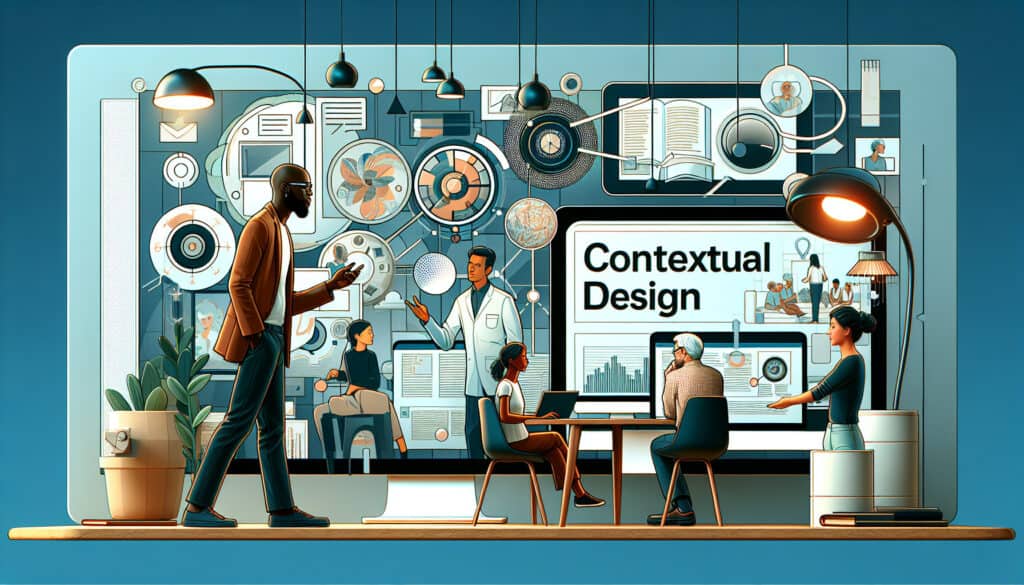A centrato sull'utente processo di progettazione che si avvale di un'approfondita ricerca sul campo (indagine contestuale) per comprendere le esigenze e le pratiche lavorative degli utenti nel loro ambiente.
- Metodologie: Clienti e marketing, Economia, Progettazione del prodotto
Design contestuale

Design contestuale
- Progettazione per la sostenibilità, Processo di progettazione, Pensiero progettuale, Convalida del progetto, Human-Centered Design, Usabilità, Test di usabilità, Esperienza utente (UX), Progettazione incentrata sull'utente
Obiettivo:
Come si usa:
- I progettisti si recano sul posto di lavoro o a casa degli utenti per osservarli e poi usano questi dati per creare modelli dettagliati del lavoro, che poi guidano la progettazione del prodotto.
Professionisti
- Fornisce una comprensione profonda e contestuale delle esigenze degli utenti, porta a progetti innovativi e altamente incentrati sull'utente e aiuta a scoprire esigenze non articolate.
Contro
- È estremamente dispendioso in termini di tempo e risorse, richiede ricercatori altamente qualificati e il processo di analisi dei dati può essere complesso.
Categorie:
- Clienti e marketing, Ergonomia, Progettazione del prodotto
Ideale per:
- Progettare prodotti basati su una comprensione profonda e contestuale dell'utente, ottenuta grazie alla ricerca sul campo.
La metodologia del Contextual Design trova ampia applicazione in settori come l'elettronica di consumo, la sanità e l'automotive, dove la necessità di prodotti incentrati sull'utente è fondamentale. Questo approccio viene spesso utilizzato nelle prime fasi del processo di progettazione, in particolare durante le fasi di sviluppo del concetto e di test. Le iniziative sono tipicamente guidato da team di progettazione, ricercatori utenti e ingegneri che collaborano strettamente con le parti interessate e le organizzazioni per garantire che le esigenze degli utenti finali siano incorporate fin dall'inizio. Le osservazioni sul campo possono rivelare le sfide quotidiane che gli utenti incontrano, consentendo ai progettisti di creare modelli contestuali dettagliati che catturano i flussi di lavoro, i fattori emotivi e le influenze ambientali, portando a soluzioni innovative che potrebbero non emergere attraverso le tradizionali ricerche di mercato. Gli studi di design, le startup e le aziende affermate coinvolgono sempre più spesso gli utenti attraverso workshop di co-design, in cui i partecipanti condividono direttamente le loro esperienze, aumentando l'empatia e la comprensione mentre contribuiscono attivamente al processo di progettazione. Questo scambio dinamico spesso si traduce in prodotti che non sono solo funzionali, ma che risuonano profondamente con gli utenti a livello personale, rispondendo a esigenze latenti che in precedenza potevano non essere riconosciute. Di conseguenza, i team possono ottenere un maggiore allineamento con le abitudini e le preferenze degli utenti, con conseguente aumento della soddisfazione, del coinvolgimento e dell'accettazione da parte del mercato delle soluzioni sviluppate.
Fasi chiave di questa metodologia
- Condurre studi sul campo per raccogliere dati osservativi dagli utenti nel loro ambiente naturale.
- Identificare le attività chiave, i flussi di lavoro e i punti dolenti attraverso l'immersione e l'interazione.
- Creare diagrammi di affinità per organizzare i comportamenti osservati e i risultati contestuali.
- Sviluppare modelli visivi come diagrammi di flusso, modelli di sequenza e modelli culturali per rappresentare le interazioni degli utenti.
- Generare quadri di progettazione che comprendano le esigenze e i contesti degli utenti sulla base delle intuizioni del modello.
- Iterare i concetti di design utilizzando i cicli di feedback degli utenti per perfezionare e migliorare i prototipi.
- Convalidare le soluzioni progettuali attraverso la co-progettazione e la sperimentazione con gli utenti in contesti rilevanti.
Suggerimenti per i professionisti
- Sfruttare la prototipazione iterativa basata sulle intuizioni osservative per perfezionare continuamente i progetti insieme ai cicli di feedback degli utenti.
- Utilizzare il diagramma di affinità durante la sintesi dei dati per identificare schemi e motivazioni sottostanti che potrebbero non essere immediatamente evidenti.
- Impegnatevi in esercizi immersivi di gioco di ruolo per sperimentare l'ambiente e i compiti dell'utente, rivelando sfide nascoste e opportunità di innovazione.
Leggere e confrontare diverse metodologie, raccomandiamo il
> Ampio archivio di metodologie <
insieme ad altre 400 metodologie.
I vostri commenti su questa metodologia o ulteriori informazioni sono benvenuti su sezione commenti qui sotto ↓ , così come tutte le idee o i link relativi all'ingegneria.
Contesto storico
1986
(se la data non è nota o non è rilevante, ad esempio "meccanica dei fluidi", viene fornita una stima approssimativa della sua notevole comparsa)

Post correlati
Simulazione di Monte Carlo
Test basati su modelli
Controllo del modello
Ricerca con metodi misti
A prova di errore (Poka-Yoke)
Test del profilo di missione